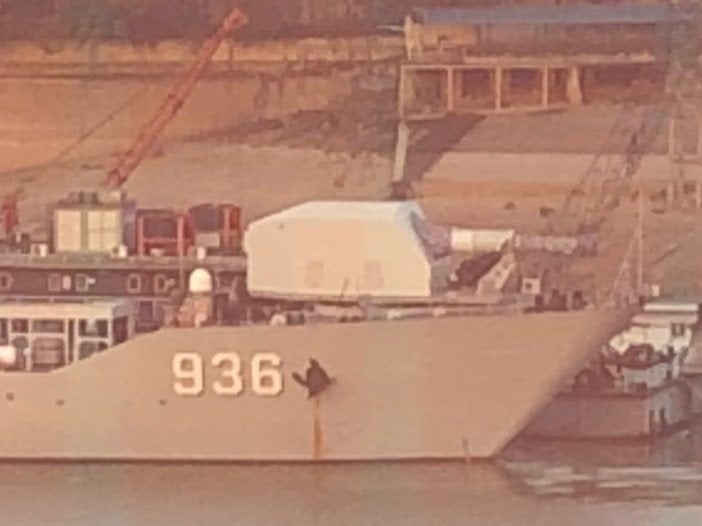Looks like China just installed a railgun on a warship, beating the U.S. Navy to the punch
Railguns are another way the PLAN hopes to get an edge in 21st-century naval warfare.


Type 055A
Pictures surfacing online appear to show a new weapon developed in China. The nation may have just installed a full-scale railgun on a warship, something even the United States Navy has yet to do.

How railguns work
Railguns use electromagnetic energy, rather than gunpowder, to sling a projectile. The concept has been incredibly appealing to militaries, as the weapon offers the speed and efficiency of a cannon, but with the range of a missile.

A Global First
Photos shared on Twitter show that the Chinese Navy’s Type 072III landing ship tank (LST) Haiyang Shan, #936, has a new turret installed on its bow, replacing the H/PJ76F 37mm anti-aircraft turret. There are also three shipping containers.

Close-Up
The turret spotted indicates the presence of a railgun. It’s large, for one, with a barrel that measures 26-33 feet in length and 12 to 20 inches in diameter. That’s 2-3 times the cannon caliber of conventional tube artillery barrels, which generally have a diameter-to-caliber ratio of 1.25:1. Alternatively, a 350-400mm naval mortar could explain the the barrel diameter and length, but such a large mortar would be hilariously unnecessary.
Due to weight issues, there is virtually no reason for a conventional cannon to have this kind of diameter-to-caliber ratio, and so the barrel’s size likely accommodates magnetic rails to propel shells to hypersonic speeds. The shipping containers are another indicator; it’s likely they contain some sort of power equipment, like generators or capacitors.
Its barrel length makes the Chinese railgun similar in size to the BAE 32 megajoule railgun built for U.S. Navy testing. The BAE system is designed to fire 22-pound projectiles at Mach 7 speeds to more than 100 miles.

USN Railgun
The United States had earlier planned to install a railgun prototype on the USNS Trenton fast transport in 2016, but this was postponed for budgetary reasons. In fact, current railgun research funding has been reported as in trouble, as the Pentagon focuses first on equipping conventional naval guns with the railgun’s low-drag, high-speed ammunition.

A Work in Progress
China’s advancing work in railgun and other electromagnetic technologies shouldn’t come as a surprise. In addition to copious open-source research by Chinese scientists, a program led by Rear Admiral Ma Weiming has in the past hired Chinese military engineers to build state-of-the-art electromagnetically assisted launch system (EMALS) catapults for future Chinese aircraft carriers. The program also built integrated electrical propulsion systems (IEPS) to meet the electrical needs of future Chinese warships.
And keep in mind: just because the railgun is there doesn’t mean the railgun actually works. Engineers for this test, as with all other railgun work, will have to overcome formidable challenges in material durability, power storage, and projectile guidance. If successful, however, it would offer China a game-changing capability. A working railgun would likely be installed on future versions of the Type 055 destroyer, which makes sense considering the vessel has been reported to have IEPS, which would meet the electrical demands of railguns and other direct-energy weapons like lasers.
In terms of benefits, the railguns’ hypersonic (Mach 5+), long-range projectiles would be perfect for cheaply and quickly knocking out high-threat air targets like ballistic missiles, aircraft, and even future hypersonic vehicles. The long range would also come in handy for missions like anti-ship warfare, supplementing shorter-ranged antiship ballistic and cruise missiles. Finally, such long-ranged artillery would be a significant addition to long-range bombardment of ground targets.
Peter Warren Singer is a strategist and senior fellow at the New America Foundation. He has been named by Defense News as one of the 100 most influential people in defense issues. He was also dubbed an official “Mad Scientist” for the U.S. Army’s Training and Doctrine Command. Jeffrey Lin is a national security professional in the greater D.C. area.